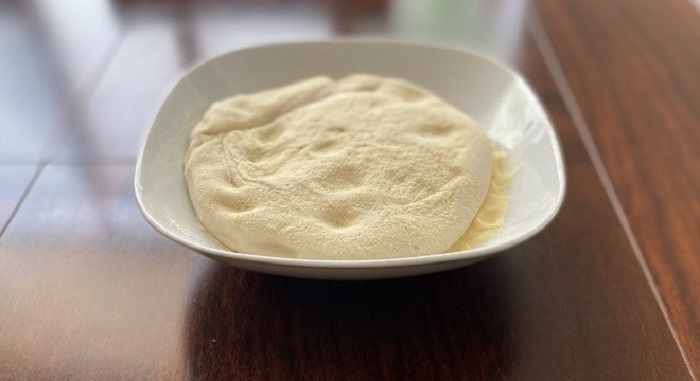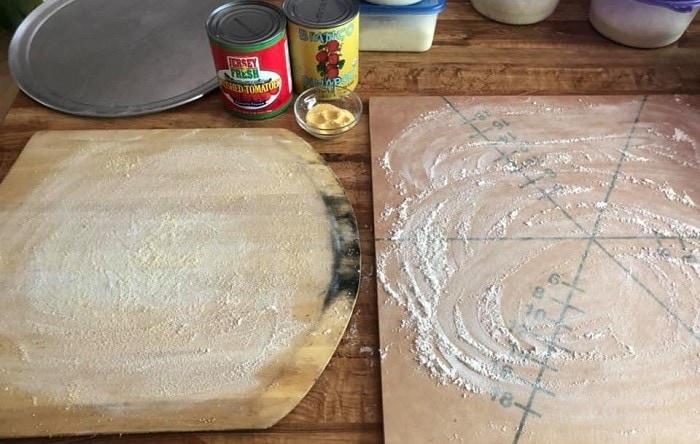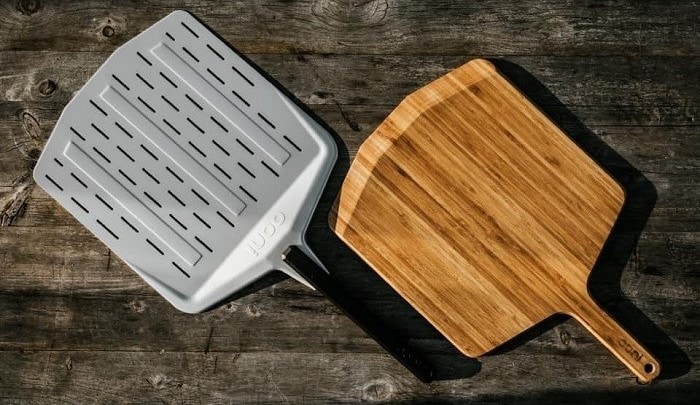Pizza Ovens Web participates in various affiliate programs, which means we may get paid commissions on certain products purchased through links in our blog.
Your pizza Dough Sticks To The Peel? Here Is How To Fix It
Let me guess, you got here because one out of two of these reasons, (most likely the second):
The first and worst one is –
You just made a batch of pizzas and as you were about to launch one of them. Then the dough had a rough time coming off the peel and it ended up with a mess on your pizza stone.
If that is your case, you can skip to the detailed guide down below that explains how to prevent your pizza dough from sticking to the peel in future bakes.
The second reason is – you are about to launch a pizza, but it is stuck to the peel and won’t move.
Why does that happen? Well, most likely you just left the pizza too long on the peel, and it absorbed all it’s moister and got stuck to it.
What should you do now?
Try using this first aid way to fix it –
- pinch the dough at the edge.
- slightly lift it up from the peel.
- throw some semolina/flour under the pizza.
- Rinse and repeat around the pizza until it moves smoothly on the peel.
Now after you fixed it, lets dive straight into the complete guide for preventing your pizzas from sticking to your peel ever again:
Table of Contents
1. season your dough with semolina

The first step you must do to prevent your dough from sticking to the peel is to get your dough coated with semolina or flour.
Semolina is a type of flour that pizzerias and professional pizza chefs use for stretching the dough. Semolina helps reduce the friction between the dough and the surface, and it also adds a nice authentic touch to the taste of the pizza.
Semolina and flour work quite the same. The only two main differences are the taste and the fact that flour burns easier inside a pizza oven. I also found that semolina adds more of a Neapolitan taste to the pizza, while regular flour will have a New York-style taste.
Seasoning your dough with it can be done in a few ways, but personally, the least messy way I found doing it is this:
Fill a bowl with some semolina, then take the dough out of the proofing box, dip both sides in the bowl, and repeat a few times.
2. Make sure your peel is completely dry and clean
Before we move to the next step I want you to pay attention to a very common mistake people do – they use a wet or dirty peel.
A wet pizza peel is a straight path for problems. When your peel is wet, the friction between the peel and the dough will DRASTICALLY increase.
As a result, the pizza will stick to the peel and you will have a rough time getting it off onto the stone.
The solution is simple:
Always make sure your peel is dry and dusted with some flour. You should also wipe off excess cheese or sauce between lunches so the peel always stays clean and smooth.
3. Dust your peel with a little bit of semolina

After you ensured your peel is dry and clean, the next step will be dusting it with a little bit of semolina or flour.
The semolina helps reduces the friction between the pizza and the peel, or in other words, the pizza will move like butter on your peel.
A seasoned peel makes a really big difference, after I started doing it, my pizzas could move much easier on the peel, and it made the launching a piece of cake.
4. use a wooden or a Perforated peel

After you read the heading you probably wonder, what is wrong with just a smooth metal peel?
So let me explain with an example from my own experience:
When I was still making pizzas in my regular home oven, I used a simple wooden peel, and to be honest? – It worked perfectly fine for me.
All the process was smooth and I rarely had my dough stick to the peel.
Then I got my first pizza oven, the Ooni Koda 16, and it came with a smooth metal peel with it.
I tried using it a few times and I just found that the dough didn’t move as easy as it did with my old wooden one, so I moved back to the origin.
But then I faced another problem that I didn’t have with my regular oven, the semolina I have dusted on my peel kept falling on the stone and caught fire.
The solution I found was a perforated non-stick peel. It works the best out of all types of peels, and it is definitely a must-have for every outdoor pizza oven owner.
5. make sure your dough isn’t too sticky
If you feel that your pizza dough is too sticky while stretching it, and dipping it in semolina didn’t help, your problem might be that the dough you made is too sticky.
If this is the case your dough will stick to the peel no matter what, so you will need to try and fix it.
If you wish to do that, we have a fully detailed guide about how to fix sticky pizza dough, so make sure you check it out.